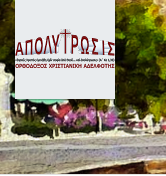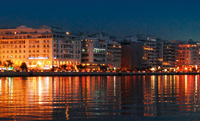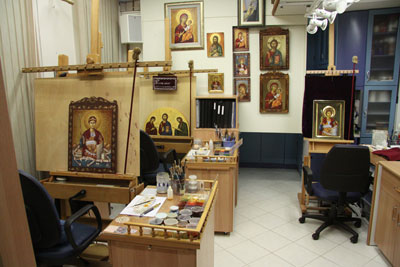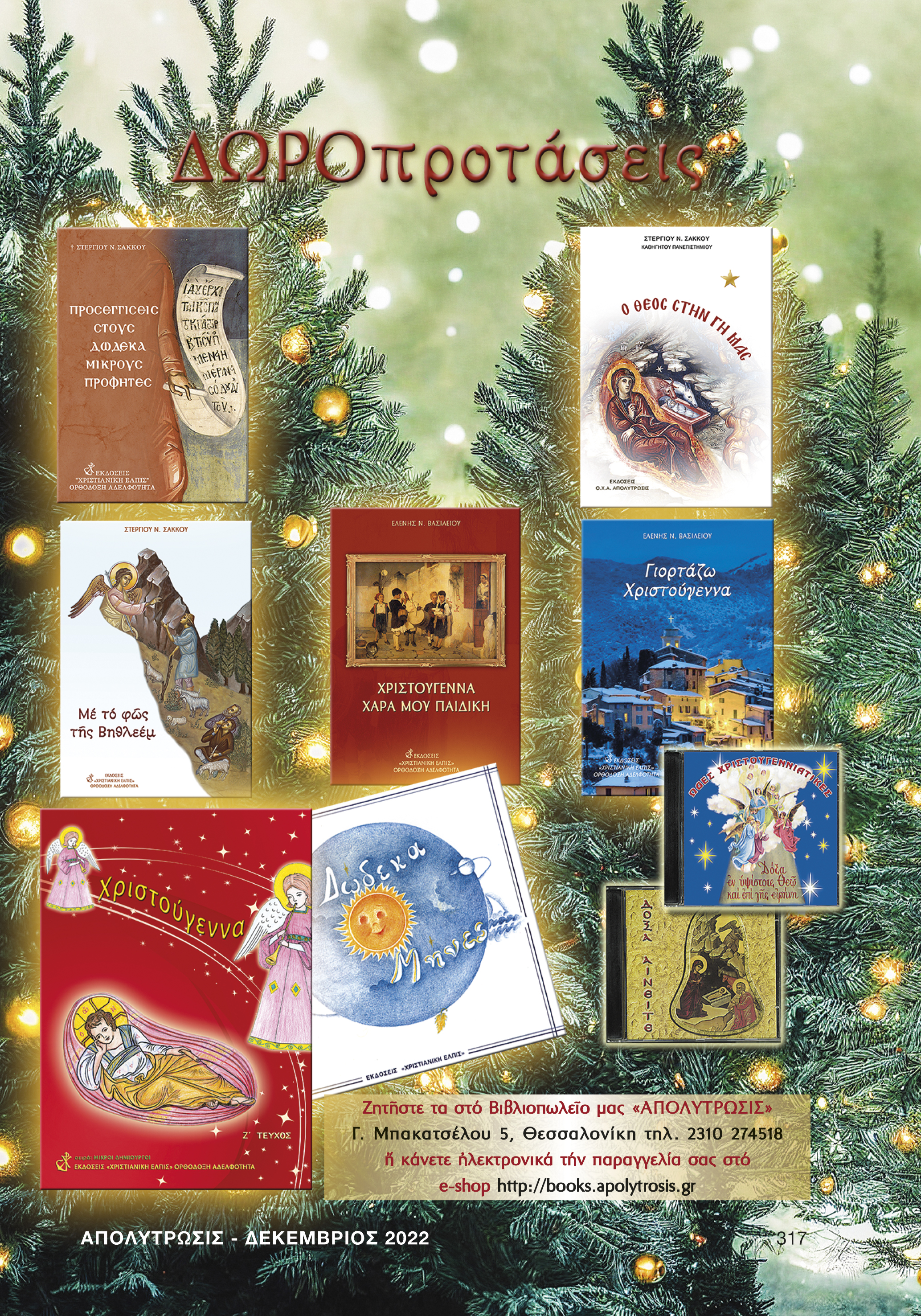 ΑΠΟΛΥΤΡΩΣΙΣ
ΧΡΙΣΤΙΑΝΙΚΗ ΟΡΘΟΔΟΞΗ ΑΔΕΛΦΟΤΗΣ
ΑΠΟΛΥΤΡΩΣΙΣ
ΧΡΙΣΤΙΑΝΙΚΗ ΟΡΘΟΔΟΞΗ ΑΔΕΛΦΟΤΗΣ

Articles (27)
Saint Dimitrios, The Catechist of Thessaloniki
Γράφτηκε από Super UserTranslated excerpts from the book:
Στεργίου Ν. Σάκκου [Read CV], Ὁ Κατηχητής τῆς Θεσσαλονίκης, ἐκδ. «ΧΡΙΣΤΙΑΝΙΚΗ ΕΛΠΙΣ» ΟΡΘΟΔΟΞΗ ΑΔΕΛΦΟΤΗΤΑ, Θεσ/νίκη 2000
Homily of Saint Gregory Palamas, On the Great Martyr, the Wonderworker, and the Myrrh-Streaming Dimitrios
His Ornament Was Faith
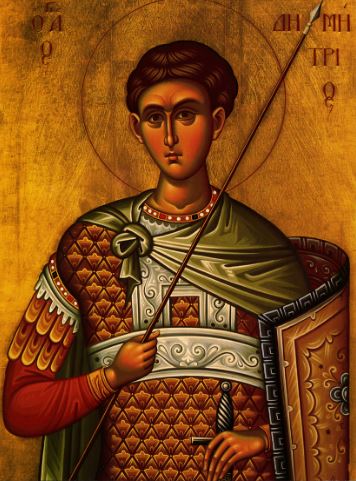
And what praise could be offered to Dimitrios—the one who adorns not only the whole world but even the heavens themselves? What, then, is his own ornament?
♦ His unconquerable faith.
♦ His measureless grace.
♦ The divine and enduring wealth of heavenly virtues, now stored above and added to the treasures of heaven as one more priceless jewel.
Even while he still lived among men, Dimitrios was already reaching toward heaven. He became himself a part of its eternal riches—a beauty belonging both to all the world and to the one beyond.
Foreseeing this, David blessed and exalted him, saying: “Blessed is the man who walks not in the counsel of the wicked, nor stands in the way of sinners” (Ps 1:1). He never allowed a single thought to enter his mind that was not devout. He never took a single step in a way displeasing to God. He kept pure and undefiled the grace he had received through Baptism in Christ. His will was perfectly attuned to the law of the Lord. It was for him the very book of God itself—like a tablet divinely inscribed, or like those stones written by the finger of God and set before all for their common good.
Beauty, Wisdom, and Purity
In the words of Isaiah, “Before the child knows how to refuse the evil and choose the good, he will refuse the evil, to choose the good” (Is 7:16). In the same way, Dimitrios, even in the bloom of youth, embraced the beauty of virginity. He devoted himself wholly to this treasure. He did all things to remain pure both in body and in soul. His way of life was already in heaven, even while his body still lived on earth. He advanced in likeness to the bodiless angels. In this struggle, all the other virtues stood beside him as companions, and above all the love to study the wisdom. Through discernment and purity he reached perfection. In a short time he brought to his youth the venerable maturity of old age. As Solomon teaches, “Understanding is gray hair to men, and a blameless life is ripe old age” (Wis of Sol 4:9).
He was, therefore, a gentle young man, radiant with beauty—not only outwardly and to the senses, but even more in the hidden depths of his soul. God, who looks upon the heart, beheld him and loved the spiritual and invisible beauty within him. He was pleased to dwell in him, to become one spirit with him, and to make him divine in every way. God once found David to be a man after His own heart. But Dimitrios, though still very young and not yet counted among the mature in years, He found exactly as His heart desired (see Acts 13:22)—“a workman who has no need to be ashamed” (2 Tim 2:15), one who fulfilled His commandments. God found in him, as Paul writes, “a chosen vessel to bear My name before the Gentiles and kings” (Acts 9:15). And, according to the Wisdom of Solomon, “a spotless mirror” (Wis of Sol 7:26), He received and reflected the transcendent and ineffable beauty.
I have heard that to him also that voice was revealed in secret: “Behold My servant, whom I have chosen, My beloved, in whom My soul is well pleased; I will put My Spirit upon him, and he shall proclaim justice to the nations” (see Is 42:1; Mt 12:18). He would transform others, making the unworthy worthy, so that he might be, as it is written, “as My mouth” (Jer 15:19). Others he would rebuke and bring to shame, showing them to be “vessels of wrath made for destruction” (Rom 9:22). And though these words were written concerning Christ, it is understood that through Him they are also bestowed upon those who live in perfect imitation of His example.
Translated excerpts from the book:
Στεργίου Ν. Σάκκου [Read CV], Ὁ Σταυρός στό φῶς τῆς Ἀνάστασης, ἐκδ. «ΧΡΙΣΤΙΑΝΙΚΗ ΕΛΠΙΣ» ΟΡΘΟΔΟΞΗ ΑΔΕΛΦΟΤΗΤΑ, Θεσ/νίκη 2019
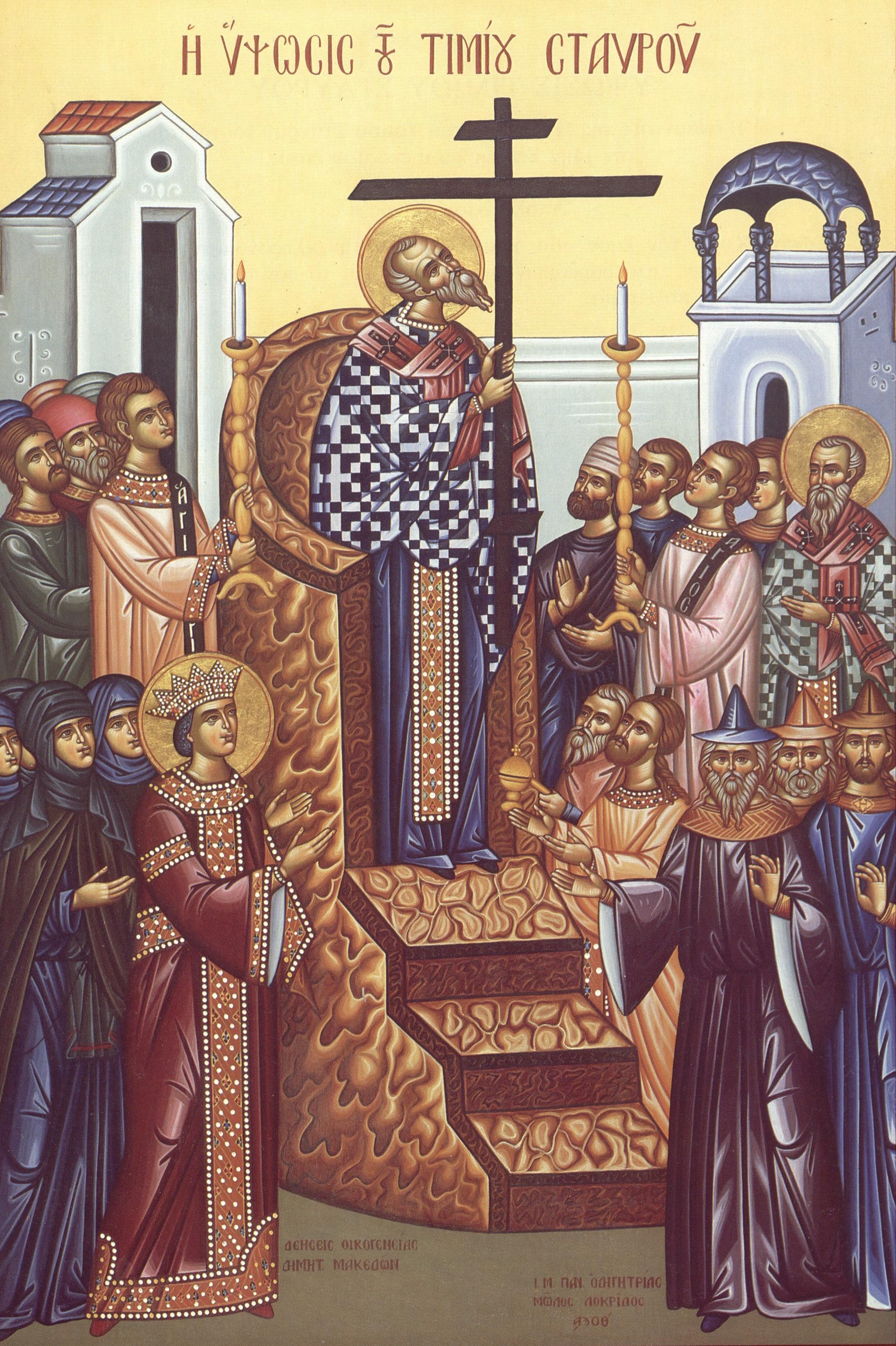 The universal Exaltation of the Precious Cross (September 14) proclaims the rejoicing of the whole created world, the redemption and happiness of every believer. It signifies what is most joyful and good—indeed, it conveys what the very word “gospel” means.
The universal Exaltation of the Precious Cross (September 14) proclaims the rejoicing of the whole created world, the redemption and happiness of every believer. It signifies what is most joyful and good—indeed, it conveys what the very word “gospel” means.
Yet, when we look back through history, we see that in the time before Christ the cross carried a completely different, dreadful, and terrifying meaning. It was the instrument of the most painful and shameful condemnation, the symbol of the dominion of evil, the curse, the banner and the trophy of the devil. No one could have dared—not only to assert, but not even to conceive—a connection or kinship of the cross with anything good and joyful.
How then did this inconceivable change take place—the transformation of the cross and its identification with the gospel? This unimaginable achievement is the work of the love, the wisdom, and the power of God. With a bold leap, God descends from heaven into the earth, into the realm of the “ruler of this world,” and seizes his dominion. He shatters his kingdom and sets free the captives held in bondage to Satan. As Jesus Christ is lifted up as the last of the condemned on Golgotha, He accomplishes the complete crushing of the adversary, the devil. The apostle Paul records in simple words the offering of Jesus Christ through the cross: “When he ascended on high he led a host of captives” (Eph 4:8). He made the captives of the ruler of this world His own, and as Lord He now raises the cross as His banner, His own flag. The God-man is now the Victor!
Of course, the above holds true only for those who confess Jesus Christ as God and accept to cooperate with Him through repentance. For the others, who willfully remain far from Christ and from His redeeming work, all this is meaningless. It is understandable, then, that they fill their daily lives with countless other symbols, while at the same time opposing and seeking to abolish the symbol of the cross.
Jesus Christ reveals to the world the cause of joy, the gospel, the blessed secret of God. It is the cross! Yes, the cross that is accompanied by pain, suffering, blood, and death. The gospel does not mean merely good words or moral teaching. It signifies the event of Jesus Christ, the condescension of God, who descends to earth in order to experience pain in its most agonizing form; He endures a series of humiliations, so that He might be nailed upon the cross as “obedient unto death, even death on a cross” (Phil 2:8). All of this, along with the teaching and preaching of Jesus Christ, is what Paul refers to as the gospel of glory. The truths of the gospel shine forth and illumine the world, and their light reveals the inexhaustible light, the Sun of Righteousness, the incarnate God, whose life is marked by the cross. For this very reason the cross is no longer disgrace and curse, but honor and glory, resurrection.
Of course, in the apostolic age the gospel had not yet taken shape as the written book we know today, nor had the cross yet come to prevail as a visible sign. This came later, when the body of the twenty-seven books of the New Testament was compiled, and correspondingly the symbol of the cross was established. Thus, when the holy apostles speak of the gospel, they mean the event of salvation. Likewise, they call the cross the crucified Lord.
Cross and gospel are identified as two sides of the same coin. The apostle Paul experiences this in a very practical way, for the gospel (see Rom 2:16) is his daily concern and the breath of his life, while at the same time he bears in his body “the marks of the cross” (cf. Gal 6:17). And our holy Church bears witness to this in visible form through the holy Gospel, which rests upon her sacred altar; on the one side it bears the cross, and on the other the resurrection. In this way it shows that the fearful suffering of the cross is the guarantee of the supreme joy of the resurrection.
This must be especially emphasized in our pleasure-seeking age, which absolutely rejects the cross or deceitfully distorts its essence; in every way it seeks to make our life painless, carefree, and free from all suffering. For this reason, today more than ever, we are unfamiliar with and untouched by true joy. Joy remains inaccessible, and the gospel fruitless and of no benefit, when the cross is “emptied,” when it loses its content. And what is the content of the cross? It is Christ Himself, His gospel. On the cross, as on a hard disk, the entire life and offering of the God-man is stored. When the Christian becomes alienated from this, he empties the Cross. The practical implications of this I will present with a series of images.
◆ The cross is the rod and the staff, our support for a secure journey along the way of God. With its strength we carry out the will of the Lord willingly and joyfully, and then “his commandments are not burdensome” (1 Jn 5:4). Without the cross, they seem impossible to us.
◆ The cross is the elevator that lifts us into the glory of God; if the elevator breaks down, we will never ascend, never experience the joy of the gospel.
◆ The cross is the umbrella that shields us from the rain of the devil; if the umbrella is pierced, it loses its protective function, and with it the joy of Christ disappears from our life.
◆ The cross is the cloak that warms us with the love of God. Without its help, unbelief chills us.
◆ The cross is the treasury that contains the precious treasure of our salvation, the vessel of myrrh in which is stored the “inexhaustible myrrh,” the “fragrance of Christ.” If we empty the treasury or the vessel of myrrh, it is of no benefit to us.
◆ The cross is a “weapon against the devil,” the missile with which we crush him. But if the missile remains unused, or if through clumsy handling it explodes in our hands, our very life is endangered. This is what happens when we do not make the sign of the cross correctly.
The cross of Christ, stained with His immaculate blood and illumined by His glorious Resurrection, stands as the decisive crossroads where two paths meet: the road to heaven and the road that leads to the ends of the earth. With the unshakable foundation of Jesus Christ, the cornerstone upon which the Church is built, the faithful overcome the attraction of the world; “they take part in everything as citizens, and they endure everything as strangers.” At the same time, they embrace all people with a love unknown and without precedent, a love whose distinguishing mark is sacrifice. This is precisely what the commandment of Christ means: “Love one another as I have loved you” (Jn 13:34). Here lies the crucial point, where the great danger lurks: as love spreads out to all, it must not wrong the holy foundation, must not empty the cross of Christ, must not distort the Orthodox faith.
Just as Jesus Christ, “without departing from His nature, partook of our human substance,” Christ became man without ceasing to be God, so also we must love everyone—yet without falsifying the faith, without defiling the doctrine, without being moved away from the foundation of the cross. Then we truly honor it and partake of the joy that the cross has poured out upon the world; we enjoy the gifts that He bestows upon our life.
Translated excerpts from the book:
Στεργίου Ν. Σάκκου [Read CV], Ὁ Σταυρός στό φῶς τῆς Ἀνάστασης, ἐκδ. «ΧΡΙΣΤΙΑΝΙΚΗ ΕΛΠΙΣ» ΟΡΘΟΔΟΞΗ ΑΔΕΛΦΟΤΗΤΑ, Θεσ/νίκη 2019
If someone were to tell us that we could hold God in the palm of our hand, we would likely consider it an exaggeration—perhaps even a blasphemy. How could the Infinite and Eternal One be confined within the grasp of five fingers? And yet, the One who surpasses time and space took on flesh and bones in the womb of a Virgin. He showed us how He can dwell with His body and blood in the very heart of a human being. His supreme condescension to our human nature is revealed time and again in the life of the Church. It gives us the assurance to accept this truth with confidence. Yes, it is true. He who holds the universe in His hands and directs life and history by His providence, allows Himself to be embraced in the palm of a faithful Christian. Through the sign traced with the right hand, we make our Christian confession.
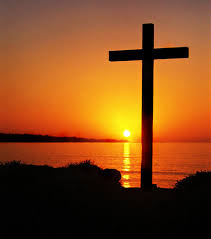 Speaking of the great mystery of faith—the Incarnation and the Resurrection of Christ—the apostle Paul speaks with clarity. Τhis wondrous work of God is fulfilled. It moves from being a historical reality to becoming a present reality in our lives. And it is accomplished through a “word”. A single utterance holds all its power: “the word of faith.” “But the righteousness based on faith says, Do not say in your heart, 'Who will ascend into heaven?' (that is, to bring Christ down) or 'Who will descend into the abyss?' (that is, to bring Christ up from the dead). But what does it say? 'The word is near you, on your lips and in your heart' (that is, the word of faith which we preach); because, if you confess with your lips that Jesus is Lord and believe in your heart that God raised him from the dead, you will be saved” (Rom 10:6–9). Our salvation depends on a confession made in faith. And God Himself is marked by a sign made in faith: the sign of the Cross.
Speaking of the great mystery of faith—the Incarnation and the Resurrection of Christ—the apostle Paul speaks with clarity. Τhis wondrous work of God is fulfilled. It moves from being a historical reality to becoming a present reality in our lives. And it is accomplished through a “word”. A single utterance holds all its power: “the word of faith.” “But the righteousness based on faith says, Do not say in your heart, 'Who will ascend into heaven?' (that is, to bring Christ down) or 'Who will descend into the abyss?' (that is, to bring Christ up from the dead). But what does it say? 'The word is near you, on your lips and in your heart' (that is, the word of faith which we preach); because, if you confess with your lips that Jesus is Lord and believe in your heart that God raised him from the dead, you will be saved” (Rom 10:6–9). Our salvation depends on a confession made in faith. And God Himself is marked by a sign made in faith: the sign of the Cross.
By joining the three fingers of our right hand into one, we signify the three persons of the Holy Trinity: the Father, the Son, and the Holy Spirit. Being of one essence, they are the one God. By folding the other two fingers together and placing them side by side, we declare the two natures that are united without confusion and without division in the person of our Lord, the God-man. Then, by tracing the sign of the Cross upon our body—with the hand on the forehead, the belly, the right shoulder, and the left—we recall the means of our salvation: the crucifixion of Christ. Through His Cross, He granted to humanity the resurrection of the dead bodies and to the Church the glory of the deification of her members. At the same time, we declare that we are crucified with the Lord, as members of His Body. In this simple act, the highest dogmas of our faith are expressed: the Trinitarian doctrine and the Christological doctrine. These are the very truths on which the ecumenical Councils of our God-inspired Fathers reflected and gave their verdict. The experienced elder and the unlearned child, the wise scholar and the humble laborer—all alike can confess the truths of the faith in this way, so long as they are Orthodox believers. And before these truths, even the angels stand in awe.
The sign of the Cross is rooted in the treasury of the Orthodox tradition, and it retains its meaning only when traced according to the way it has been handed down through the centuries. Above all, of course, it is connected with faith. It is neither an external form nor a magical symbol, but a confession of a particular faith and an invocation of a personal God. We acknowledge that God is Triune and we seek the grace that flows from the Cross of the Incarnate Lord. The immediate consequence is that it must be traced properly, fully, and completely. The hurried and careless manner that distorts its form so that it no longer resembles the Cross is unacceptable, for it reveals the absence of the most essential element: awareness and understanding. Even if we do everything correctly, but in the end neglect to complete the sign by placing our hand properly on the left shoulder, then our Cross has no validity. This is taught to us beyond any doubt by the posture of Moses’ prayer at the time when the Israelites fought against the Amalekites. As long as he kept his hands stretched wide, forming with his body the shape of a complete cross, the Israelites prevailed. But when he began to grow weary and his hands drooped and fell, changing the shape, the Israelites were defeated—even though Moses, with all his heart, continued to pray fervently. Aaron on one side and Hur on the other came to support his arms, holding them outstretched in the perfect likeness of the Cross, until the Israelites at last gained the victory. Even the slightest deviation causes the sign to lose its meaning. It’s like dialing a phone number and mistaking just one digit—one small error is enough to prevent the person you are looking for from ever answering. And could this not be the very reason we so often complain that God does not hear our prayers?
It is remarkable that one of the great missionaries of the Church, Saint Kosmas of Aetolia, persistently taught during the difficult years of the Turkish occupation that Christians should make the sign of the Cross correctly. For indeed, the Ark was for Israel the place where the symbols of the Covenant were kept. The holy Altar tabernacle (artophorion) is for the Church the place where the Body and Blood of Christ are reserved. In the same way, the sign of the Cross is the place where the doctrine of faith and salvation is safeguarded. With this, every Christian can carry intact the full treasure. It is the inheritance that God has entrusted to us. Truly, the highest honor we can offer the precious Cross of our Lord is to resolve always to make the sign of the Cross correctly, with faith and with reverence.
Translated excerpts from the book:
Στεργίου Ν. Σάκκου [Read CV], «Λάμψον καὶ ἡμῖν...», ἐκδ. «ΧΡΙΣΤΙΑΝΙΚΗ ΕΛΠΙΣ» ΟΡΘΟΔΟΞΗ ΑΔΕΛΦΟΤΗΤΑ, Θεσ/νίκη 2023.
Called to His Eternal Glory
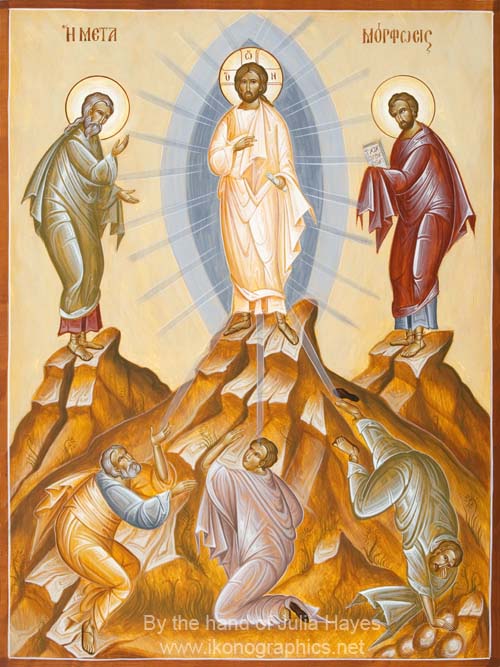 The Feast of the Transfiguration is set as the last of the Lord’s feasts in the liturgical year. As the distinguished liturgist Ioannis Foundoulis notes, this position marks the conclusion of the yearly journey through the events of the Lord’s life. At the same time, it offers a glimpse into the events of the last times: the future coming of Christ, the glory that is to come, and the deification of the human person who is being transfigured in Christ. This is the final goal and purpose of the Savior’s redeeming work.
The Feast of the Transfiguration is set as the last of the Lord’s feasts in the liturgical year. As the distinguished liturgist Ioannis Foundoulis notes, this position marks the conclusion of the yearly journey through the events of the Lord’s life. At the same time, it offers a glimpse into the events of the last times: the future coming of Christ, the glory that is to come, and the deification of the human person who is being transfigured in Christ. This is the final goal and purpose of the Savior’s redeeming work.
The faithful are already drawing near to this future glory through their whole spiritual life, lived within the life of the Church. They are conscious of the truth expressed so vividly by the apostle Paul: “But our commonwealth is in heaven, and from it we await a Savior, the Lord Jesus Christ, who will change our lowly body to be like his glorious body, by the power which enables him even to subject all things to himself” (Phil 3:20–21).
In this present life, our body is a “body of humiliation”; it is subject to sickness, weakness, decay, and pain. But at the Second Coming, our Lord will appear in glory, and then our body will undergo a transformation. It will be stripped of all that is temporary, fragile, and incomplete, and it will be clothed with glorious perfection. It will become “conformed to the body of His glory”—like the glorified body of the God-man Jesus. “It will become like the body that sits at the right hand of the Father,” teaches Saint John Chrysostom emphatically, “like the body that is worshipped by the angels, attended by the bodiless powers—like the body that is above every principality, authority, and power!” The word “will transform” (μετασχηματίσει), notes Theodoret, does not refer to a mere change in outward form, but rather to the body’s deliverance from corruption. The body will be “conformed” to His glory, explains the same interpreter, not in the degree of glory, but in its quality: “for it too shall be radiant with light,” like a body made of light.
This astonishing and inconceivable likeness will be accomplished “by the power which enables Him even to subject all things to Himself.” The almighty Lord has the authority to subdue all things—therefore, He can also subdue corruption and death. He confirmed this hope by raising His own body from the dead.
Concerning this profound transformation that will take place at the Second Coming, we also read in the First Epistle to the Corinthians: “Lo! I tell you a mystery. We shall not all sleep, but we shall all be changed, in a moment, in the twinkling of an eye, at the last trumpet. For the trumpet will sound, and the dead will be raised imperishable, and we shall be changed. For this perishable nature must put on the imperishable, and this mortal nature must put on immortality” (1 Cor 15:51–53).
The apostle Paul reveals a mystery—something hidden—that will take place at the close of the ages: “We shall not all sleep (die), but we shall all be changed.” Not all will die, but all will undergo a transformation. The verb “we shall be changed” here carries the same meaning as “He will transform.” Those who are alive at the time of the Second Coming, the moment the Lord appears in glory, will instantly undergo a transformation. Their corruptible and mortal bodies will become incorruptible and immortal—like the glorious body of the risen Lord! “Corruption will die within them,” explains Saint Theophylact, “and will be transformed into incorruption.”
It is worth noting that, in that hour, the human being will not perish, and the unique personal identity of each will be preserved. Our self will retain the awareness of its own existence. Yet it will regain its lost radiance—the radiance it once had in Paradise before the fall. Just as our Lord, when He assumed human nature, preserved His divinity whole and unchanged—and thus was not mortal, but only liable to suffer—so too, at the Second Coming, the human body will be deified. It will not cease to be our very own human body, but it will be transformed. This same body will be changed and will become incorruptible, immortal, and glorious!
Knowing these things, then, O man,” cries out Saint Andrew of Crete, “do not make yourself unworthy of grace, nor lose the heavenly and eternal things because of a life of indulgence. Instead, put away all laziness of soul and free yourself from every earthly concern. Turn yourself completely toward what is above and heavenly. Embrace the spiritual union with the Word—a pure and blessed union—which brings deification and the enjoyment of inexpressible blessings. Bring your soul and your life there, near to Him. It is a good thing to be with God. That is where the feast of the saints takes place.
Translated excerpts from the book:
Στεργίου Ν. Σάκκου [Read CV], «Λάμψον καὶ ἡμῖν...», ἐκδ. «ΧΡΙΣΤΙΑΝΙΚΗ ΕΛΠΙΣ» ΟΡΘΟΔΟΞΗ ΑΔΕΛΦΟΤΗΤΑ, Θεσ/νίκη 2023.
Spiritual Transfiguration (part 2)
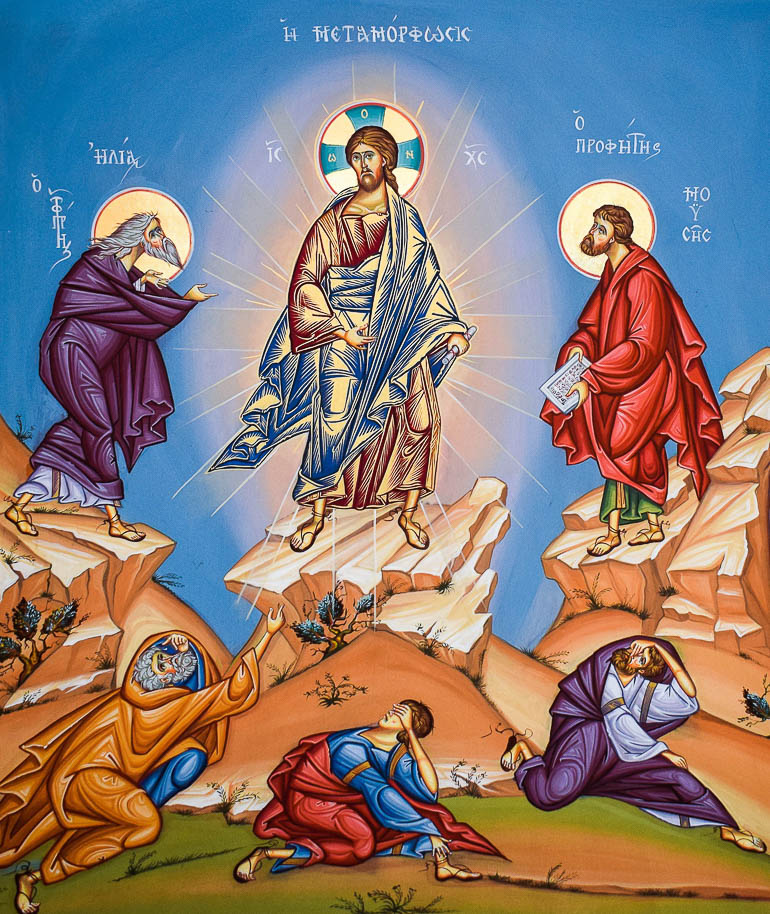 “Resist the devil and he will flee from you,” exhorts James, the brother of the Lord (4:7). We need a spirit of resistance in order to live in this world without falling under the power of its ruler. It is telling that our Lord Jesus Christ, shortly before His departure from this world, prayed for His disciples, asking His Father: “I do not pray that Thou shouldest take them out of the world, but that Thou shouldest keep them from the evil one” (Jn 17:15). He does not pray for them to be taken out of the world, but that they may be guarded from the evil one. Christians will live in the world, interact with it, cooperate with it, and yet guard themselves from the influence of the evil one.
“Resist the devil and he will flee from you,” exhorts James, the brother of the Lord (4:7). We need a spirit of resistance in order to live in this world without falling under the power of its ruler. It is telling that our Lord Jesus Christ, shortly before His departure from this world, prayed for His disciples, asking His Father: “I do not pray that Thou shouldest take them out of the world, but that Thou shouldest keep them from the evil one” (Jn 17:15). He does not pray for them to be taken out of the world, but that they may be guarded from the evil one. Christians will live in the world, interact with it, cooperate with it, and yet guard themselves from the influence of the evil one.
To the command, “Do not be conformed,” the God-inspired Apostle adds, “but be transformed.” The faithful are called not only to refrain from being conformed to this world, but also to be continually transformed in spirit. This implies a constant spiritual perfecting and growth. A standstill is never a good sign—either in the physical life or in the spiritual one. Saint Theophylact gives this counsel: “Do not say, as Peter did, ‘Lord, it is well that we are here’; for one must always make progress and not remain at one level of virtue and contemplation, but move forward elsewhere.” Spiritual advancement—spiritual transformation—is an essential mark of the Christian life.
But how is this vital spiritual transformation attained? The apostle Paul answers: through renewal. In the mystery of Baptism, we were spiritually reborn. We renewed this rebirth of Baptism when we willingly made the decision to belong to Christ—that is, to be conscious members of the Church. Yet that initial renewal is not enough. We must continually renew ourselves spiritually—we must undergo a constant renewal. Saint John Chrysostom advises: “This is exactly what we do with our homes—we are always tending to them when they grow old—do the same with yourself! Have you sinned today? Have you aged your soul? Do not despair, do not lose heart, but renew it through repentance, tears, confession, and acts of mercy—and never cease to do this.” When we neglect to renew ourselves, we begin to lose the battles of the spiritual life.
More specifically, the apostle Paul speaks of the renewal of the mind—that is, of our thoughts, our inner mindset. Through the mystery of Baptism, we have put on Christ (see Gal 3:27) and have been given “the mind of Christ” (1 Cor 2:16) — “Have this mind among yourselves, which is yours in Christ Jesus” (cf. Phil 2:5). Yet through sin the mind becomes clouded, worn down by the passions, aged by vice. “Nothing ages the soul and the body as much as sin,” observes Oecumenius.
This is why we are in constant need of renewal of the mind. “Before all else, our judgment about things must be sound,” teaches the golden-tongued Father. “And even if we do not yet practice virtue, let us at least praise it; and even if we have not yet turned away from evil, let us still condemn wickedness. In this way, we will form upright judgments—and by progressing in this way, little by little, we will also come to put virtue into practice.”
But how, then, is the human mind renewed? Through the truths of the Gospel. Just as the intellect is shaped and instructed through study, so too is the mind reshaped, purified, and illumined through the study of the Holy Scriptures—through the sacred writings. It becomes new, filled with holy thoughts, pure desires, and noble affections. In a homily for the Feast of the Transfiguration, Saint Gregory Palamas urges: “Now pay attention, I ask you, and lift up the eyes of your mind to the light of the Gospel message, so that you may at last be transformed through the renewal of your mind!”
Once the mind has been renewed, it acquires the precious virtue of discernment—the ability to recognize what the will of God is in every situation: “that you may prove what is the will of God, what is good and acceptable and perfect.” (Rom 12:2) “Discernment is greater than all other virtues,” teaches Saint Isaac the Syrian. With discernment, the believer sees all things in the light of eternity —to see with the very eyes of God. He comes to know the divine will and strives to live it out in his daily life, submitting himself to the command spoken by the heavenly Father at the Transfiguration: “Listen to Him.” (Mt 17:5) Through this obedience, he is continually refined, uplifted, and spiritually transformed.
Translated excerpts from the book:
Στεργίου Ν. Σάκκου [Read CV], «Λάμψον καὶ ἡμῖν...», ἐκδ. «ΧΡΙΣΤΙΑΝΙΚΗ ΕΛΠΙΣ» ΟΡΘΟΔΟΞΗ ΑΔΕΛΦΟΤΗΤΑ, Θεσ/νίκη 2023.
A Fact of Our Personal History
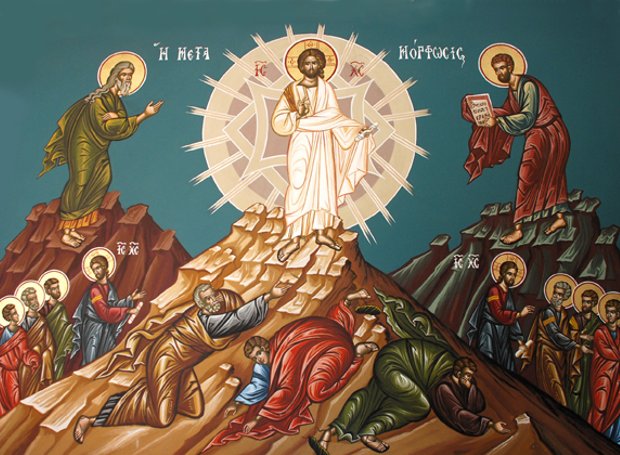 The historical event of the Transfiguration, as the Fathers of our Church emphasize, did not take place only once. It is an event of the past, the present, and the future. It is an event of the life of Christ, which occurred “at that time” on the holy mount of the Transfiguration, but also a reality that unfolds within the present course of history. This is confirmed by countless transfigured souls, who speak of their experience with a sweetness, a joy, and an exultation beyond expression. Furthermore, it is also a future event for every believer, who looks forward to a new transfiguration when he meets Jesus at the end of the world. The more he prepares himself each day through spiritual transfiguration for that final encounter, the more fully he will partake forever in the vision of the glorious Lord.
The historical event of the Transfiguration, as the Fathers of our Church emphasize, did not take place only once. It is an event of the past, the present, and the future. It is an event of the life of Christ, which occurred “at that time” on the holy mount of the Transfiguration, but also a reality that unfolds within the present course of history. This is confirmed by countless transfigured souls, who speak of their experience with a sweetness, a joy, and an exultation beyond expression. Furthermore, it is also a future event for every believer, who looks forward to a new transfiguration when he meets Jesus at the end of the world. The more he prepares himself each day through spiritual transfiguration for that final encounter, the more fully he will partake forever in the vision of the glorious Lord.
Spiritual Transfiguration (part 1)
The consistent living of the Christian life advances and spiritually transfigures the believer. Yet it requires his wholehearted spiritual struggle. This struggle is not driven by impersonal moral commandments but is inspired by the love of Christ. The recognition of this love, and the longing to respond to it, urges the believer to rise above his own desires and to submit to the will of God. Such submission becomes the offering most acceptable to God, offered in return for the saving sacrifice of our Lord Jesus Christ. This is precisely the sacrifice urged by the apostle Paul at the beginning of the twelfth chapter of the Epistle to the Romans; “I appeal to you therefore, brethren, by the mercies of God, to present your bodies as a living sacrifice, holy and acceptable to God, which is your spiritual worship. Do not be conformed to this world but be transformed by the renewal of your mind, that you may prove what is the will of God, what is good and acceptable and perfect” (Rom 12:1–2).
Having demonstrated in the first part of the Epistle—the theological section (chapters 1–11)—that Jesus Christ is the only Savior and Redeemer of all people, both Jews and Gentiles alike, the Apostle now calls upon the faithful to offer their own sacrifice in return for Christ’s redeeming sacrifice. That is, to present themselves as a living, holy, and acceptable sacrifice to God.
He does not, of course, mean the destruction of their bodies. As Theodoret explains: “For he does not command the bodies to be slain, but rather to be dead to sin.” What is required is the mortification of sin—the spiritual worship—which consists not in the offering of irrational animals, but in two things: love and purity (cf. Jas 1:27). Interpreting this apostolic exhortation, Saint John Chrysostom poses the question: “How can the body become a sacrifice? Let the eye look upon nothing evil, and it has become a sacrifice. Let the tongue speak nothing shameful, and it has become an offering. Let the hand do nothing unlawful, and it has become a whole burnt offering. Or rather, these are not sufficient; we also need acts of charity: that the hand may perform almsgiving, that the mouth may bless those who mistreat us, and that the ear may be constantly occupied with the hearing of the words of God.” We offer spiritual worship, as Saint Theophylact sums up, “when no irrational passion holds sway within us, when each person becomes the high priest of his own self and slaughters within him his vices.”
Yet in the world in which we live, we encounter many obstacles that prevent us from offering this spiritual worship unhindered. That is why the apostle Paul makes a second appeal: “Do not be conformed to this world but be transformed by the renewal of your mind.”
“To be conformed” means “to take on the same form,” the same outward appearance (see Phil 2:8). The Apostle instructs the faithful: you must be different; you must not be carried away by the worldview and way of life of “this present age”, of the world that surrounds you. That world has as its “ruler” the devil (see Eph 6:12), for it willingly submits to him. You, however, must not adopt its philosophy or its manner of living (cf. Jn 17:15–16; 1 Jn 2:15–17). If the faithful become identical in all things with the godless world, how will they fulfill the mission entrusted to them by the Lord: to be “the light of the world” (Mt 5:14), “lights in the world” (Phil 2:15)? If they yield to the influence of others, how shall their own life exert any influence upon the world around them? Worldliness—making compromises in order to please the desires of the world—will have disastrous consequences, both for their own spiritual life and for the society in which they live.
The motto of the first Christians, as we read in “The Didache of the Twelve Apostles”, holds true in every age: “Let grace come, and let this world pass away!” Against the world! Just as living fish swim against the current, while the dead are carried away by it. Against the world that constantly wears us down, distorts us, estranges us from God! Against the enticements, the demands, the fashions of the world!
Especially in our days, we all face the danger of worldliness, which assails us with the terrible flood of the pursuit of well-being and a life of ease. In truth, it has affected us all. It has wounded us deeply and holds us bound in chains; we can no longer find the strength to cast off its yoke. It would be good for us to ask ourselves often: “Am I truly a Christian?” Do I walk with Christ along the narrow and “hard” way, or do I follow the world along the wide and easy road? (see Mt 7:13–14).
Translated excerpts from the book:
Στεργίου Ν. Σάκκου [Read CV], «Λάμψον καὶ ἡμῖν...», ἐκδ. «ΧΡΙΣΤΙΑΝΙΚΗ ΕΛΠΙΣ» ΟΡΘΟΔΟΞΗ ΑΔΕΛΦΟΤΗΤΑ, Θεσ/νίκη 2023.
The Event of the Transfiguration in the Gospels
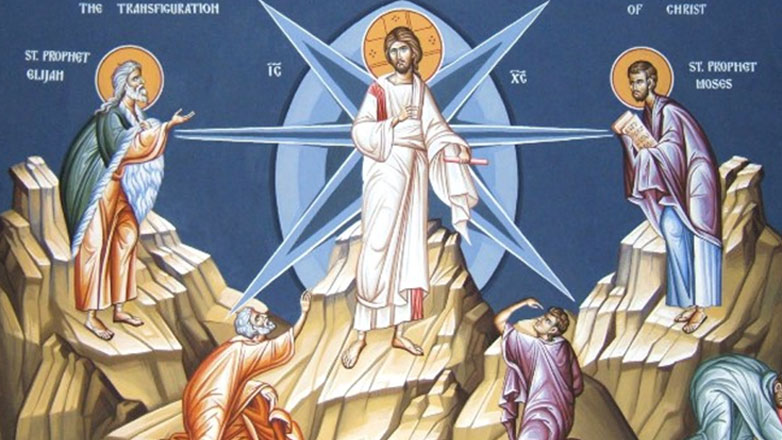 Undoubtedly, the God-man Jesus Christ, during His earthly ministry, revealed His divinity in many ways: through His holy life, His words full of divine grace, the supernatural signs He performed upon inanimate creation (the feeding of the five thousand, the calming of the storm on the Sea of Galilee), as well as upon human beings themselves (healings, resurrections of the dead). However, during the Transfiguration, His revelation took place in a wholly unique manner. There, to the extent permitted by human nature, His divine glory was revealed. This event is narrated by the evangelists Matthew (17:1–8), Mark (9:2–8), and Luke (9:28–36). The evangelist John refers to it briefly, without narrating it (1:14), because he wrote his Gospel later, when the Transfiguration was already known from the other three Gospels that were circulating.
Undoubtedly, the God-man Jesus Christ, during His earthly ministry, revealed His divinity in many ways: through His holy life, His words full of divine grace, the supernatural signs He performed upon inanimate creation (the feeding of the five thousand, the calming of the storm on the Sea of Galilee), as well as upon human beings themselves (healings, resurrections of the dead). However, during the Transfiguration, His revelation took place in a wholly unique manner. There, to the extent permitted by human nature, His divine glory was revealed. This event is narrated by the evangelists Matthew (17:1–8), Mark (9:2–8), and Luke (9:28–36). The evangelist John refers to it briefly, without narrating it (1:14), because he wrote his Gospel later, when the Transfiguration was already known from the other three Gospels that were circulating.
The Transfiguration took place “on a high mountain” (Mt 17:1; Mk 9:2). There, Jesus was with only three of His disciples, away from the crowds, “by themselves” (Mt 17:1; Mk 9:2). The most paradoxical and wondrous things were performed by the Lord secretly and quietly, so that He might not be regarded by the crowds as “a man in appearance only,” as Saint Theophylact observes. Moreover, the Lord did not intend to display His glory before the multitude. His purpose was to grant His own disciples such an experience that they might not be scandalized or irreparably shaken at the time of the Passion, which He had just foretold to them. Through the Transfiguration, He revealed to them His divinity, in order to provide them with unshakable testimony — a firm assurance that His Passion was voluntary, in accordance with the eternal plan of the Triune God for the redemption of humankind. This is also proclaimed in the Kontakion of the feast:
Kontakion — Tone 7
On the mountain You were transfigured, O Christ God,
and Your disciples beheld Your glory as far as they could bear;
so that when they would see You crucified,
they would understand that Your suffering was voluntary,
and would proclaim to the world
that You are truly the radiance of the Father.
The Lord chose Peter, John, and James to go up with Him onto the mountain. Three witnesses were sufficient to confirm an event, according to Deuteronomy: “On the evidence of two witnesses or of three witnesses, a matter shall be confirmed” (see Deut 19:15). So, three disciples were enough to bear witness to the Transfiguration. These same three were also with Him at the raising of Jairus’ daughter (Mk 5:37) and during the agony in Gethsemane (Mt 26:37). Saint John Chrysostom explains: “These were superior to the others.” These three stood out among the Twelve and seem to have formed the core of the group. Peter, as we observe in the Book of Acts, later emerged as the foremost among the apostles. John was the only one among the disciples who followed Jesus as far as the Cross of Golgotha (see Jn 19:26). James was the first among the apostles to suffer martyrdom (see Acts 12:2). These, then, were the ones whom the Lord chose to take with Him, so that they might later be able, at the appropriate time, to convey to the others what they themselves had experienced.
The Transfiguration took place “as He was praying” (Lk 9:29). The Lord had gone up onto the mountain with His disciples in order to pray. He frequently withdrew to pray in deserted places (see Mk 1:35; Lk 5:16) and in the stillness of the mountains (see Mt 14:23; Lk 6:12). The God-man was Himself a constant and unceasing prayer. Yet He also made it His practice to pray as a man, so as to inspire His disciples by His example. It was not, therefore, the first time that the disciples saw their Teacher praying (see Lk 11:1). Only on that particular occasion, however, did the Lord allow the radiance of His divinity to become visible during His prayer. If He had allowed this to happen more often, there would have been the danger that His human nature might be questioned, and that He might be considered as only appearing to be human.
In order to grasp, at least in some way, what took place during the Transfiguration, the following example may be helpful — though undoubtedly very imperfect, as it expresses only human reality:
Four soldiers, wearing their cloaks, ascend a mountain on a mission. Along the way, as they converse in a friendly manner, they call one another “comrade.” Upon reaching the summit of the mountain, they sit down to rest. At a certain moment, one of the “comrades” unbuttons part of his cloak, and the others then notice the insignia of a general beneath it. How great their astonishment and admiration! They realize that the one who had humbly walked among them as a simple soldier was, in fact, a general.
So also, we could say, during the Transfiguration, Christ “unbuttoned” His human nature, as it were; He opened the human garment that covered His divinity and allowed a portion of His divine glory to be revealed. It was not possible, of course, for Him to show it in its fullness, for the human eyes of His disciples would not have been able to bear beholding it in all its majesty. Regarding the Lord’s garments, the evangelist Matthew says that they became white as light, while Mark describes them as being like snow, with such a dazzling whiteness that no human effort could achieve it. According to the interpretation of the Fathers, the body of the Lord was entirely radiating the glory of divinity. That is why, as Saint Gregory Palamas clarifies, “His garments, which touched His body, became radiant. And through them, He revealed the garments of glory that those who draw near to God will wear in the age to come.” This light emitted by the Lord’s body and garments was not the ordinary light that makes colors appear brighter, but a light of a different kind — a light that transformed even the garments themselves into light. It was the uncreated light of divinity, which shone forth for the first time on the Mount of the Transfiguration.
Alongside Jesus there appears an exceptionally honored company: Moses, the unparalleled leader and prophet (see Deut 34:10), through whom God delivered His people from bondage in Egypt, and Elijah, the zealous prophet (see 1 Kgs 19:10, 14), who was taken up into heaven without tasting death (see 2 Kgs 2:11).
The two men from the Old Testament appear “in glory” (Lk 9:31), bearing the glory that crowns the saints in heaven (see 1 Pet 5:4). Moreover, according to Saint John Chrysostom, the two men from the Old Testament appeared in order to encourage the disciples by hearing their conversation with the Lord concerning His “departure” (see Lk 9:31). The prophets of the Old Testament had prophesied both about Christ’s entrance into the world and about His departure. His entrance refers to the birth of Jesus, and His departure refers to His death, resurrection, ascension, and His glory in heaven. Before the Transfiguration, the Lord had spoken to His disciples about His departure, and they were filled with fear. Now, the prophets Elijah and Moses appear, conversing with the Lord about the same matter — reminding the disciples of the related prophecies, encouraging them, and strengthening their hearts.The departure of Jesus was arranged by His own will. It was destined to take place in Jerusalem (Lk 9:31), which is the city that “kills the prophets and stones those who are sent to it” (Mt 23:37).
The Transfiguration was not a dream or a vision in the sense of a mere apparition, because three disciples saw it simultaneously. It was a vision (the word is derived from the verb “to see”), a viewing of an actual reality — not something imaginary — a “vision” in the sense in which the term is used by the prophets (cf. Is 1:1). The three disciples, having entered into the frequency of the Spirit, ceased to see and hear with their natural senses. They acquired perception of the supernatural reality with their minds fully alert and through the illumination of the Holy Spirit, by uncreated light. In this way they beheld the glory of the Lord and heard His conversation with the two men from the Old Testament.
While Peter was asking to set up tents, a tent not made by hands appeared: a cloud, as a sign of God’s presence (see Ps 96:2; 103:3). Many times, the presence of God was made perceptible to the Jews through a cloud: in the wilderness after their exodus from Egypt (see Ex 13:21), on Mount Sinai (see Ex 19:16), in the Tabernacle of Testimony (see Ex 40:28), and at the dedication of Solomon’s Temple (see 1 Kings 8:10). A cloud was also the chariot with which the Lord ascended into heaven (see Acts 1:9), and in clouds the faithful will be caught up at the Second Coming to meet Him (see 1 Thess 4:17). The cloud overshadowed the Lord, the two prophets, as well as the three disciples (see Lk 9:34). From within the cloud, a voice was heard. In the event of the Transfiguration, as at the event of the Baptism, all three persons of the Holy Trinity are revealed: the Son is revealed as the God-man in His transfiguration; the Holy Spirit makes His presence known through the luminous cloud; and the Father through the voice that is heard.
The voice of the Father, saying, “This is My beloved Son, with whom I am well pleased” (Mt 17:5; cf. Mk 9:7; Lk 9:35), reveals that the Son is of one essence with the Father. In ancient Greek, the adjective “beloved,” when referring to a son, often means “only-begotten.” The Only-Begotten Son of God, by necessity, is of one essence with God the Father. Just as every human son shares the nature of his human father, so also the Son of God possesses the divine nature, sharing the same essence as God the Father. He “bears the very stamp of his nature” (Heb 1:3). Moreover, the divine voice from within the cloud exhorts: “Listen to Him” (Mt 17:5; Mk 9:7; Lk 9:35). It urges the three disciples of Jesus — and all who will believe in Him — to obey Christ, to submit with trust to His will, even when He calls them to self-denial and sacrifice.
Only with the encouragement of their Teacher did the disciples, who had fallen to the ground in fear (see Mt 17:7), rise again. And as they were coming down from the mountain, the Lord gave them a strict command not to tell anyone what they had seen until after His resurrection (see Mt 17:9; Mk 9:9).
Translation from the article:
Στεργίου Ν. Σάκκου, Τί σημαίνει Ὀρθοδοξία, περιοδ. "Ἀπολύτρωσις" 50 (1996) 56-57.
(Stergios N. Sakkos, University Professor [Read CV])
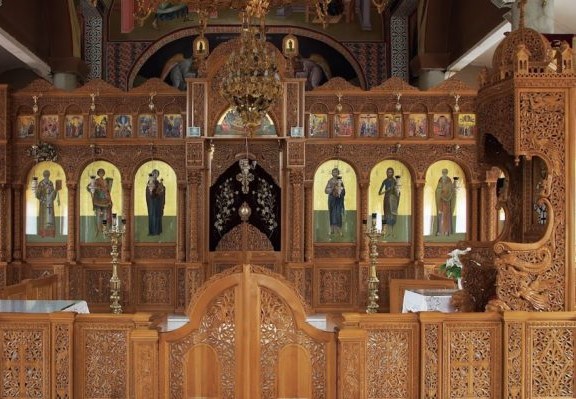 Many people talk about Orthodoxy these days. We hear them on TV channels, we read them in newspaper columns, we see them as authors of various publications and books. According to their words, Orthodoxy is a type of culture or a type of folklore, depending on the guiding preference of each relevant thinker. It is a form of civilization - always exceptional and unique - or a characteristic of the people of Romiosini (Helenism)- in any case special and worthy of attention. This makes Orthodoxy seem more like an ideology, a philosophy or a worldview, a popular religion, than the revelation of God that it really is.
Many people talk about Orthodoxy these days. We hear them on TV channels, we read them in newspaper columns, we see them as authors of various publications and books. According to their words, Orthodoxy is a type of culture or a type of folklore, depending on the guiding preference of each relevant thinker. It is a form of civilization - always exceptional and unique - or a characteristic of the people of Romiosini (Helenism)- in any case special and worthy of attention. This makes Orthodoxy seem more like an ideology, a philosophy or a worldview, a popular religion, than the revelation of God that it really is.
The Orthodox Church of Christ also speaks of Orthodoxy. And it speaks not only now, when it is fashionable to speak about Orthodoxy and to be in the light of publicity, but it has been speaking for at least twenty centuries, from the moment it was born and it speaks in the low tones of humble speech in the devout atmosphere of the meek spirit. For those of us who are genuinely interested in Orthodoxy, I think it is worth paying attention to it, because it is the only one that deserves our attention, because the Orthodox Church is the only expert on the subject.
We could say - with a very general simplification, of course, for practical reasons - that Orthodoxy is identified with the Church, the one, holy, Eastern Church. Its characteristics are the characteristics of the Church and they are none other than the characteristics of the God-man person of Jesus Christ, since the Church is the mystical Christ, which extends throughout the ages, according to the expression of Saint Augustine. This is revealed by the teachings of the Fathers, who have been the pillars of the Church, it is demonstrated by the lives of the saints who martyred for Orthodoxy, it is testified by the common conscience of the Orthodox faithful. Thus, we have immediately and surely a specific and clear view of Orthodoxy, which the history of the Church irrefutably testifies to.
First of all and above all, Orthodoxy is a way of life based on divine truth. It certainly creates culture, shapes ethos, but these are results, not its essence. Orthodoxy is the path of God, which requires that it be walked in obedience to the revealed truth and with discipline in the divine commandment. The combination of the right faith (orthodoxy) with the holy living (orthopraxis) is a characteristic of Orthodoxy “of those things which are not without.” The apostle Paul formulates this verbatim for the umpteenth time when, at the end of his life he confesses to his disciple Timothy, “I have fought the good fight, I have finished the course, I have kept the faith” (2 Tim. 4:7).
The Church delivers the doctrine and the commandment, holding in one hand the inspired Scripture and in the other the sacred Tradition. Doctrines are the revealed truths of the divine word as formulated by enlightened saints after the Church’s struggles and battles with evil and deceitful spirits. Commandments are the ethical exhortations of the divine word, as lived by the saints of every age, who were not conformed to any scheme of their time, but were transformed into vessels of the Holy Spirit. But all this could never be accepted by human beings if they tried to follow it on their own - individually or in groups, but autonomously - by their own reason and personal efforts.
Those who have tried have either given up or erred and have not remained Orthodox. One must hear the doctrine- in order to be able to interpret it - and obey the command to be able to carry it out - united in one body and tuned to one frequency in the body whose head is Christ and whose members are the saints of all ages, and to the frequency that the Holy Spirit emits within this divine-human community.
The means of participation in the Church of Christ are the Holy Mysteries and spiritual worship. Through the grace of the mysteries, the Orthodox person is united with the Triune God, receives the forgiveness of sins and, in spite of all his finitude and imperfection, lives the infinity and perfection of eternity. In divine worship, moreover, through prayer and hymnody, he has the blessing of expressing himself before the Lord, praising His greatness, thanking him for His love and praying with contrition of his weakness. Together with the angels and the simple saints of Orthodoxy, who signify their presence with the holy icons all around, all the faithful “with one accord and in the same spirit” invoke and receive divine grace in the Church. Everything there is a sacred symbol, expressing in its own language, so evocative and profound, the doctrine and ethos of the Church, which teaches in silence. For this reason, all the elements of worship are considered genuine expressions of Orthodoxy: the icons, the hymns and the ritual.
But Orthodox life is not limited to the temple, nor does it stop at worship. It spreads out and covers every moment of the Christian’s life, continuing and permeating his every movement. In the temple of the believer’s body, there is a constant logical worship and a constant mystical communion with all the faithful of the Church. This is achieved through the Holy Spirit and is expressed by the sign of the cross, which literally marks every Orthodox. The shape of the Holy Cross is not only mentally traced on occasions with the three fingers of the right hand united in the name of the Holy Trinity, but it also constantly traces the life of the Christian who, for love of God, constantly contrasts his will with the will of the world and of his former unredeemed self, patiently endures pain and voluntarily suffers for the good, denies himself and gives himself to others, in a word, practises asceticism. Indeed, the ascetic element is a trademark of Orthodoxy. It takes many forms in Orthodox life: fasting, vigil, poverty, purity, sacrifice; but it is always a cross that imitates the Cross of Christ, and therefore bears His glory.
How many of the Orthodox speakers of our time can really identify themselves with these qualities? Every year the Church dedicates a Sunday to the name of Orthodoxy. On this Sunday, it emphasizes above all the mission of evangelization that it has towards the world, the task of proclaiming the Orthodox faith and life throughout the world. Perhaps it is time to let its voice to be heard louder and clearer today, amidst the clamor of so many, so that we may finally learn what Orthodoxy means.
Translation from the book:
Στεργίου Ν. Σάκκου, Ὁ Σταυρός στό φῶς τῆς Ἀνάστασης, ἐκδ. «ΧΡΙΣΤΙΑΝΙΚΗ ΕΛΠΙΣ» ΟΡΘΟΔΟΞΗ ΑΔΕΛΦΟΤΗΤΑ, Θεσ/νίκη 2019, σσ. 50-56.
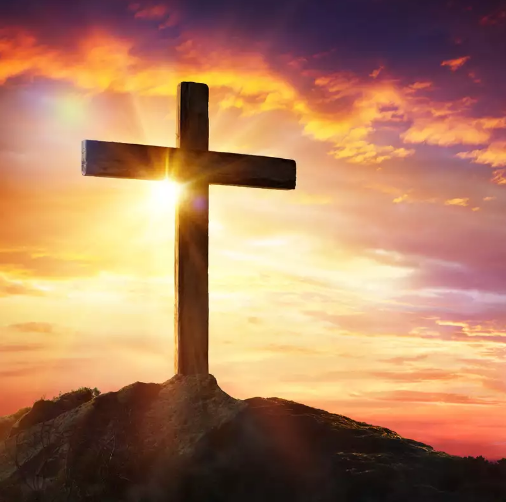
It is a good opportunity that gives us something we need most now that the summer holidays are coming to an end, now that we are going back to our jobs, now that the daily hard work and the struggle to survive are pressing us from within. At this time we need the strong hand of the mighty crucified God to steady us. We need a warm embrace, the heart-warming embrace of the compassionate Jesus. His bleeding hands are wide open on the Cross, reaching out to us and assuring us of the power of His love. “Christ loved us and gave himself up for us, a fragrant offering and sacrifice to God. (Eph 5:2).
The whole world is scented by this sacrifice. The angels praise, creation rejoices and the Church delights, but while all this is happening, selfish man is unaware of it because his spiritual senses are blocked by his “ego”. Nevertheless, the Cross is the most vivid evidence of the divine consent that can gladden the universe. “For behold, through the Cross joy has come to the whole world”, we proclaim in the Easter Prayer, and indeed we are joyful because our soul finds peace under the Cross. Our daily joys become deeper when we realise that they are secured by a sacrifice. And our frequent misfortunes become lighter when we feel that God sympathises with us.
Life is like a sea, full of storms, but the pious can hold the cross in front of them. In this way, they can stop the waves and walk safely through it, just as Moses parted the Red Sea. When a loved one faces danger, temptation or sickness, in situations where no help can be offered, the pious can cross themselves. The Lord grants victory to His people, just as Moses was granted the victory of the Israelites over the Amalekites. Sometimes people are like troubled travellers in the world, wandering thirstily between ideological and philosophical currents, finally losing their love for life because they cannot find a single drop of water except bitterness and disgust. If they faithfully drop the cross in their anguish, their existence will become sweet like the water of the Merra spring in the desert.
Our Lord has told us in many ways that He loves us, and He shows us His love at different times in our lives. But what uniquely and unquestionably guarantees His love is the height and breadth of His Cross. If we wanted to distinguish and measure the great revelations of God’s love for humanity, we would highlight five: the creation of the world, the history of Israel, the Holy Cross, the Holy Scriptures and the Church.
The world is the precious heritage that the Creator has given to His creature, so that its beauty may delight us and its riches nourish us.
Israel of the Old Testament is our special ancestor who has protected the truth of our descent and divine kinship through the centuries. The miraculous deliverances of the Israelites from their mighty enemies reassure us that we are safe in God’s hands.
Christ’s revelation of Himself, His name, His glory and His plan for our eternal relationship is our great priceless treasure, deposited in the written Word of God and never to be spent. Our faith in it helps us to live and enjoy here and now, there and forever.
The Church, the people of God, is our holy family which Christ has made for His children without distinction. His love fills our souls with joy and dispels all fear, for it is from the present to the end of time.
All these great gifts are given to our lives with the embrace of God. But the Cross is God’s embrace, opened to us who are dirty, wounded or even dead, so that we can be cleansed, healed and resurrected. God hangs on the cross and suffers for us. He takes our wickedness and gives us virtue. He undergoes an adventure not because he owes us anything, but to save us from being lost. He loses His glory and spills His blood to give us glory and life. God becomes man because He wants to make man God, so that we can be with Him forever and have eternal joy. The love that our soul desires is embodied on the Cross. It assumes the dimension of God and is revealed in the face of the crucified Christ, who longs for us.
In any case, the Cross exists in the depth and essence of all God’s gifts. The Cross holds the Church together, because the sacrifice of Christ on the Cross is the foundation and strength of the Church. God’s plan for our salvation, revealed in Scripture, is contained in the simple form of the Cross. The Cross justifies the purpose of the Church. The Cross sanctifies the universe and reconciles man with his outer and inner world. Creation and history, Revelation and the Church hang from the holy wood on which our Saviour was crucified.
We too are called to hang from His Cross, however heavy and burdened we may be, so that we may feel light. To put at his root all that troubles us, to open our hearts to His love and our arms to His embrace. This is the love we need to live, as the Apostle Paul says: “And the life that I now live in the flesh I live by the faith in the Son of God, who loved me and gave himself for me” (Gal 2:20). We cross ourselves, we embrace the risen Cross of the Lord and we are lifted up into His embrace. Let us be carried by His mercy.
Copyright © 2021 by Orthodox Christian Association
«ΧΡΙΣΤΙΑΝΙΚΗ ΕΛΠΙΣ» ΟΡΘΟΔΟΞΗ ΑΔΕΛΦΟΤΗΤΑ. Used by permission. All rights reserved.
Translation from the book:
Στεργίου Ν. Σάκκου, Ὁ Σταυρός στό φῶς τῆς Ἀνάστασης, ἐκδ. «ΧΡΙΣΤΙΑΝΙΚΗ ΕΛΠΙΣ» ΟΡΘΟΔΟΞΗ ΑΔΕΛΦΟΤΗΤΑ, Θεσ/νίκη 2019, σσ. 43-49.
Among the banners, flags and symbols raised by the world to proclaim its slogans, our Church exalts the Holy Cross and invites us to accept its message. The history of God and man, in all its dimensions, is written on its simple shape. The greatest misery and the greatest joy meet in its heart: the despair of a dying world and the hope of a world being raised.
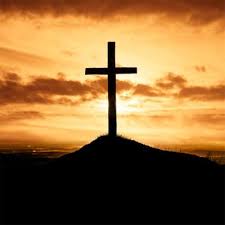 Historically and theologically the Cross has in fact, two aspects: what it appears to be and what it is. It appears to be dipped in blood, tears and pain. But if we bend over its bloody stains, we will again discern two opposites: on the one hand, crime in its most terrible form, guilt in its most dreadful hour; and on the other, the greatest love and infinite tolerance. The cross of ancient times, was an instrument of torture, the most terrible means that Satan had discovered to torment man, after he had driven him to the lowest point of degradation. But since the Crucifixion of the sinless Christ, the Cross has also become the symbol of the highest love and devotion for those who love Christ and follow in His footsteps.
Historically and theologically the Cross has in fact, two aspects: what it appears to be and what it is. It appears to be dipped in blood, tears and pain. But if we bend over its bloody stains, we will again discern two opposites: on the one hand, crime in its most terrible form, guilt in its most dreadful hour; and on the other, the greatest love and infinite tolerance. The cross of ancient times, was an instrument of torture, the most terrible means that Satan had discovered to torment man, after he had driven him to the lowest point of degradation. But since the Crucifixion of the sinless Christ, the Cross has also become the symbol of the highest love and devotion for those who love Christ and follow in His footsteps.
There are three crosses on Golgotha which help us to understand historically the aspect of the cross represented in its two dimensions. On two of the crosses hang two criminals who are receiving “the due reward of their deeds”; on the other Cross hangs Jesus, who “has done nothing wrong” (Lk 23:41). At the same time, the first criminal cursed the Innocent, while the other repented and became a martyr; he bore his cross with patience, denied his shameful past and believed in a glorious future. And how? With the strength that he drew from the Cross of Jesus Christ. This is the second aspect of the Cross that all those who repent and believe can experience.
The Cross of our Lord has a rich inner content which can be infused into the cross of the thief and into every cross, if we so wish. This secret content, its indescribable richness, is the love of God, which becomes blood, and the blood becomes redemption and purification, but also a power of transformation and change. Here is the “essence” of the Cross, here is the hope of the world! A hope not like the “false hopes” of the poets, which lead to despair, nor like the fleeting hopes of our narrow horizons which leave behind them disappointment. It is the hope for which the soul of man thirsts, that he is not just a piece of earth and flesh, not a number or something destined to nothing but a being of eternal value and destiny. This hope which warms the heart and enlightens the mind, which steels the nerves and sustains the will, the hope which gives meaning to struggles, joyful endurance to sorrows, profound happiness to joys, is found only in the Cross. What honour man has when, for his sake, the precious blood of God is shed! What glory awaits him since the God-man, in a human body, fights and conquers death. What hope springs from Golgotha!
Unfortunately, the world can only see the visible aspect of the cross and rejects it. Like the Jews who saw its weakness and were tempted, like the Gentiles who saw it as folly and mocked it. The world ignores the “essence” of the Cross and doesn’t even bother to learn it, so it can never understand it. That is why today the Church, the Gospel and christians are despised, mocked, hated and fought against. But it is also the reason why today the world has lost hope and is dying of despair. It is because man has cut himself off from the Cross and relies on his own strength. He cannot even think that what he wants might be hidden in the Cross. In no way do people admit that the Cross, which they consider trivial, can embrace those who are divided, give peace to the soul, make amends between man and his God.
So man struggles all alone. He sends out rockets, literally throws his money into the air, without earning anything, not a breath of life, not a drop of relief from his stress. He raises his antennas, his science and his art, and channels mainly elements of corruption and decay into his own house, his mind and his blood. He hangs horseshoes on his door as a symbol of good luck, you see, this is neither foolish nor scandalous! He reconciles fetishism with his culture because he suffocates without hope. But hope is nowhere to be found! Modern man stands disappointed before an empty Pandora’s box; his last hopes have flown away. He believes nothing, he hopes for nothing, he is lost. He puts “Hope Wanted” in the “Classifieds” in vain. He will only find hope in the Cross.
Because hope is not in “bread and spectacle”, it is not in the refrigerator or in culture. Hope is not in shop windows, shops, chimneys, oil tanks and bombs. Hope is peace and life. A full stomach and a comfortable career are not hope, hope is a pure and light heart. The saturation of the senses and the deception of our secret desires with their substitutes are not hope. Hope is the power that guarantees joy up to eternity, the power that makes us see the other person not as a target for our vice or as an object to profit from, but as a brother, as a creature of the same Father.
If we see the Cross as a simple symbol, we do injustice to the Cross and, fatally, to ourselves. If we recognise in the Cross the blood of an Innocent Man who shed His blood on it for our sake, we have taken an important step. But if we discover in the Cross, beyond the agony of death, the triumph of life that springs from the “empty tomb” of the Crucified and Risen One, then we have found our great, true, eternal hope.
Our Church, through the Exaltation of the Holy Cross, invites us to rest under its wings. Tell me, dear faithful, if a person wants something different or something more!
Copyright © 2021 by Orthodox Christian Association
«ΧΡΙΣΤΙΑΝΙΚΗ ΕΛΠΙΣ» ΟΡΘΟΔΟΞΗ ΑΔΕΛΦΟΤΗΤΑ. Used by permission. All rights reserved.
